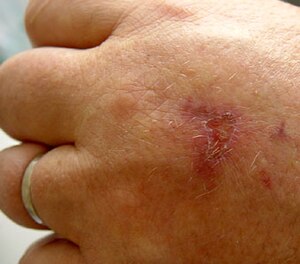| Image via Wikipedia |
It
is possible to develop an allergy to almost anything; this could be a
smell, food, medication or reactions to dander found on animals. An
allergy can range from nothing more than an annoying itch to the more
serious of going into shock after developing a severe reaction.
Allergies are usually divided into different categories that include:
Eczema
and urticaria – these are allergies which affect the skin; they
include allergic skin rashes such as nettle rash and hives.
Hay
fever – this condition causes reactions such as runny nose,
sneezing, coughing and sore eyes during the summer months.
Venom
allergies – these are reactions to stinging insects and snakes.
Adverse
food reactions – people can be allergic to many different types of
food.
Allergy
to drugs – certain medications can cause a reaction in people; the
usual reactions to drugs include a rash, sickness and stomach
problems.
Anaphylaxis
– a severe and sudden intense allergic reaction that affects the
whole body.
Asthma
– an allergic reaction that commonly affects the breathing.
Eye
allergies – this can vary from very mild irritation to severe
conjunctivitis.
Diagnosing
allergies
If
your doctor believes that you may have an allergy then steps will
need to be taken to identify what is causing it, the allergen. The
most common way of finding the allergen is to perform a skin prick
test. The skin prick test is quick and relatively painless and the
results are known immediately.
A
small needle is used to gently prick your skin with the allergen; the
test will usually be conducted on your forearm. You are determined to
be allergic to the allergen if your skin becomes red, sore and itchy
around the area the needle was inserted. It is also usual for the
area to come up in a welt. If you have had no reaction to the
allergen after a period of roughly 20 minutes then you aren’t
allergic to that allergen.
If
it is suspected that you have dermatitis - a form of eczema then you
will normally be given a skin patch test, this test relies on taping
patches with various allergens underneath aluminum discs. The discs
are usually kept in place for a period of 48 hours and then assessed
by a dermatologist for allergic changes.
Severe
cases
In
severe cases of allergy you might be required to have a challenge
test to be performed in hospital. The suspected allergens are then
introduced directly into the lungs or nose and the allergic reaction
is then measured. If it is suspected that you might be allergic to
food or foods then a double blind placebo test may be used. The food
or foods that are thought to cause a reaction are given in a capsule
under supervision, and then you wait to see if you develop a reaction
to it. This type of test however is only done in extreme
circumstances because despite it being the most reliable way it is
also the most time consuming.


No comments:
Post a Comment